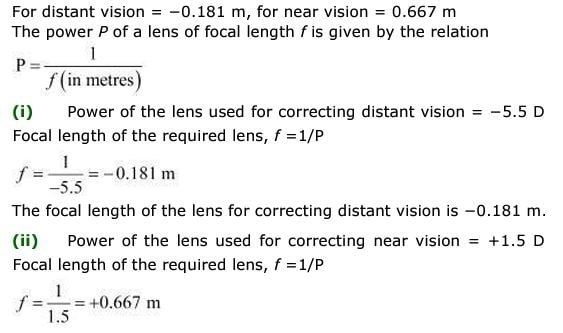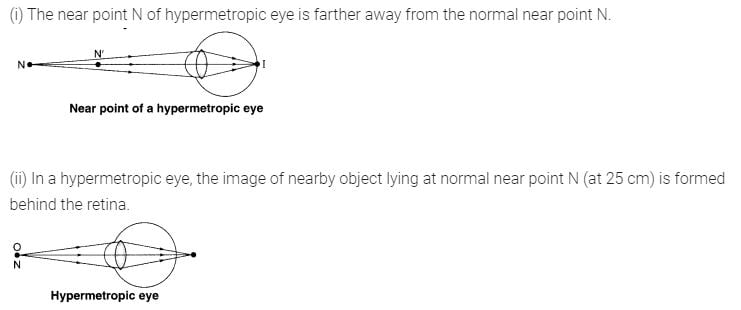Table of Contents
ToggleNCERT Solutions Class 10 Science Chapter 10 (The Human Eye and the Colourful World)
NCERT Solutions for Class 10 Science Chapter 10 Intext Questions
NCERT Solutions Class 10 Science Chapter 10 (The Human Eye and the Colourful World)
Page Number: 164
Question 1
What is meant by power of accommodation of the eye ?
Answer:

Question 2
A person with a myopic eye cannot see objects beyond 1.2 m distinctly. What should be the type of the corrective lens used to restore proper vision ?
Answer:

Question 3
What is the far point and near point of the human eye with normal vision ?
Answer:

Question 4
A student has difficulty reading the blackboard while sitting in the last row. What could be the defect the child is suffering from ? How can it be corrected?
Answer:

NCERT Solutions for Class 10 Science Chapter 10 Exercise Questions (Textbook Chapter End Questions)
NCERT Solutions Class 10 Science Chapter 10 (The Human Eye and the Colourful World)
Question 1
The human eye can focus objects at different distances by adjusting the focal length of the eye lens. This is due to
(a) presbyopia
(b) accommodation
(c) near – sightedness
(d) far – sightedness
Answer:

Question 2
The human eye forms the image of an object at its
(a) cornea
(b) iris
(c) pupil
(d) retina
Answer:
Question 3
The least distance of distinct vision for a young adult with normal vision is about
(a) 25 m
(b) 2.5 cm
(c) 25 cm
(d) 2.5 m
Answer:
Question 4
The change in focal length of an eye lens is caused by the action of the
(a) pupil
(b) retina
(c) ciliary muscles
(d) iris
Answer:

Question 5
A person needs a lens of power -5.5 dioptres for correcting his distant vision. For correcting his near vision he needs a lens of power +1.5 dioptre. What is the focal length of the lens required for correcting (i) distant vision, and (ii) near vision ?
Answer:

Question 6
The far point of a myopic person is 80 cm in front of the eye. What is the nature and power of the lens required to correct the problem ?
Answer:

Question 7
Make a diagram to show how hypermetropia is corrected. The near point of a hypermetropic eye is 1 m. What is the power of the lens required to correct the defect ? Assume that the near point of the normal eye is 25 cm.
Answer:


Question 8
Why is a normal eye not able to see clearly the objects placed closer than 25 cm ?
Answer:

Question 9
What happens to the image distance in the eye when we increase the distance of an object from the eye ?
Answer:

Question 10
Why do stars twinkle ?
Answer:

Question 11
Explain why the planets do not twinkle ?
Answer:

Question 12
Why does the sky appear dark instead of blue to an astronaut ?
Answer:


Light Reflection and Refraction in NCERT Solutions Class 10 Science chapter 10 (The Human Eye and the Colourful World): You candidates may obtain class 10 NCERT solutions for light reflection and refraction in this page. Practicing the light chapter of the Class 10 NCERT answers will assist candidates in developing a solid understanding of Physics. Understanding class 10 questions and answers related to light reflection and refraction will also help students achieve a respectable grade on their class 10 board exams.
This post contains class 10 numerical problems related to light reflection and refraction in addition to the NCERT Solutions Class 10 Science chapter 10 (The Human Eye and the Colourful World). Examining them will provide candidates a clear understanding of how to approach the difficulties, which will enable you to find the most effective solution. Why then wait? Discover everything there is to know about light reflection and refraction in class 10 by reading on for key questions and answers.
The organisation of NCERT Solutions Class 10 Science chapter 10 (The Human Eye and the Colourful World) presents a clear overview of scientific subjects that are relevant to everyday life. Students have been taught basic science with no clear distinctions between subjects like biology, chemistry, and physics. All of the country’s schools acknowledge and promote NCERT. Here are some explanations for why you should trust NCERT Solutions:
Students are forced to think creatively and apply the principles they have learnt in the chapter by the challenging questions that are put between the chapters.
You may get comprehensive answers to the chapter problems in NCERT Solutions, which will help you do well on the CBSE exams.
Students like using NCERT Solutions, particularly in the subjects of science and maths. This section contains the NCERT Solutions Class 10 Science chapter 10 (The Human Eye and the Colourful World). The solutions to all of the problems in the textbook are clearly explained. Get the complete set of NCERT Solutions for Light Reflection and Refraction in Chapter 10 here for free!
One of the most significant chapters in Class 10 Science is NCERT Solutions Class 10 Science chapter 10 (The Human Eye and the Colourful World). The most recent marking scheme assigns a weightage of 7 marks to this chapter. Students will gain a thorough understanding of light phenomena including refraction and reflection in Class 10 Science’s NCERT Solutions Class 10 Science chapter 10. Drawing ray diagrams, spherical mirrors, and image generation will all be covered.
Ever wonder why certain things are visible to us? Light is the answer to the query. Sunlight aids in our ability to see items during the day. An item reflects light when it hits it. When this reflected light reaches our eyes, it aids in our ability to see. Light is responsible for many amazing occurrences, like the birth of stars and rainbows, among many others. Let’s examine the phenomena of refraction and reflection utilising the straight-line propagation of light in NCERT Solutions Class 10 Science chapter 10 (The Human Eye and the Colourful World). In this chapter, we will also attempt to comprehend how spherical mirrors reflect light by utilising the NCERT Solutions from Bhautik Study.
Light Reflection and Refraction in NCERT Solutions Class 10 Science chapter 10 (The Human Eye and the Colourful World): Key Elements of the NCERT Solutions
offers thorough responses to every query posed in the chapter.
The material offered is accurate and suitable, and the language used is clear and understandable to all.
You can use these solutions for Olympiads, CBSE exams, and other competitive exams.
Students are given concise responses to aid in their understanding.